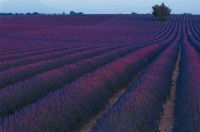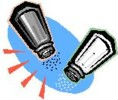
Other articles you might enjoy:
1. Take Time to Stop and Eat the Flowers
5. Pantry Basics from the Basics at Home Series
Make the most of culinary herbs and spices.
All About Lavender
by Sandra Bowens

"I judge that the flowers of Lavender quilted in a cap and dayly worne are good for all diseases of the head that come of a cold cause and they comfort the braine very well." William Turner, A Newe Herball, 1551.
Mr. Turner's "prescription" aptly shows how lavender has been used throughout history. One of the earliest recorded uses was to perfume bath water. The name Lavandula is even taken from the Latin words to wash, lavare.
Its floral yet pine-like scent permeated the air as lavender burned like incense to disinfect early hospitals and it was sometimes used in the combination of aromas that made up smelling salts. Today, lavender is a popular fragrance in soaps, perfumes and potpourri mixtures.
Only recently has lavender come into vogue as a culinary ingredient. Surely, the herbes de Provence combination of lavender, thyme, rosemary and savory has been popular around France for a long time. However, most American herb references from the 1960s and '70s make no mention of using lavender in cooking.
Lavender is often associated with sweets but adventurous chefs are taking the French example and adding it to savory dishes. In his award winning book Sauces, James Peterson suggests using lavender as a substitute for thyme or marjoram and crushing it with garlic to add to a dish in the last few minutes of cooking.
Lavender's taste of sweet fresh-cut wood and rosemary give an unusual, yet pleasant, accent to a wide array of foods. Try it in sweet or savory baked goods, with chicken and lamb, potatoes, herbal teas, jams and jellies, or as a flavoring for vinegars and honey. Grinding lavender with granulated sugar is an excellent vehicle for incorporating it into dessert recipes as well as a wonderful way to sweeten lemonade.
Although the wooly-looking leaves are fragrant and edible, the pretty purple flowers and buds are the best for cooking. Dried lavender is nearly as good as fresh and is available as loose flowers or still on the stem. If you do not see it among the other herbs and spices, look for it with tea-making supplies. Don't be discouraged by the price per pound which may be around $60, it is so lightweight, you probably won't need more than an ounce or so. Use a light hand when seasoning with lavender, too much will give an astringent taste.
Because lavender is a popular crafter's item, it is important to make sure that flowers you purchase for cooking have been grown for that purpose. It may be labeled as "culinary lavender" or "food grade."
Or grow your own! Lavender is a lovely addition to your landscape. Plant it in a place where it will be brushed against frequently or is easy to reach out and touch. Lavender has long been used for fragrance and beauty in formal gardens. The grayish-green foliage stays attractive year around. The spikes of six to ten small pale purple flowers will appear in June and July in most climates. Lavender grows as a shrub reaching up to three feet in height and does best in full sun. The flowers should be harvested just before the blooms open.
The plant is native to Mediterranean regions but is cultivated throughout the world. Roughly thirty species of lavender are known today. The seeds are slow to germinate so it is best propagated through cuttings.
Ideas seem to differ as to what lavender symbolizes. Some sources suggest distrust while others say love or acknowledgment. Shakespeare seemed to agree with the latter: "She sent him Lavender, owning her love."
Fresh Fruit and Lavender Parfaits
1 cup whipping cream, chilled
3 Tablespoons lavender sugar (see below)
1 cup crumbled crisp coconut macaroon cookies (or Amaretti)
2 cups blueberries or chunks of peaches (or nectarines), or a combination
1 teaspoon dried lavender buds, for garnish
About an hour before preparing the dessert, chill a glass bowl (3 or 4 cup capacity) and the beaters of an electric mixer in the freezer.
Pour the cold whipping cream into the chilled bowl and stir in the lavender sugar. Whip at high speed until the cream has doubled in volume and will hold a soft peak. This will take a few minutes.
In four parfait or wine glasses, alternate layers of the cookies, the fruit and the whipped cream twice. Sprinkle each dessert with 1/4 teaspoon of the lavender buds. Serve immediately.
Makes four servings.
Lavender Sugar: Grind 1 cup granulated sugar and 2 Tablespoons dried lavender buds together in a blender until the sugar takes on a purple hue and the lavender buds are no longer visible. Use extra for sweetening lemonade or tea or for baked goods.
Here's one that's full of our favorite recipes because we wrote the book! It is also full of information, helpful hints and ideas for using herbs and spices in your kitchen.
Learn to cook with lavender year around. From soup to desserts, this collection of 120 recipes will surprise and delight you.
Go home with the Herbfarm's award-winning chef as he shows you how to prepare these simple yet utterly delightful recipes.
This site's readers love this book. Filled with glorious photographs, it will give you new ideas for a lovely flower garden that tastes good too.
Tea is an herb too, and can make a delicious addition to a wide variety of foods. Here are 100 recipes to get you started.
back to top






